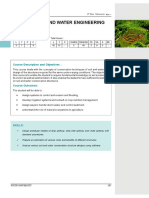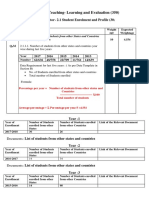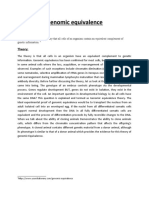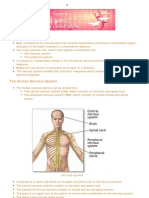Inbreeding and Crossbreeding
Uploaded by
చిమ్ముల సందీప్ రెడ్డిInbreeding and Crossbreeding
Uploaded by
చిమ్ముల సందీప్ రెడ్డిLecture 7:
Inbreeding and
Crossbreeding
Inbreeding
Inbreeding = mating of related individuals
Often results in a change in the mean of a trait
Inbreeding is intentionally practiced to:
create genetic uniformity of laboratory stocks
produce stocks for crossing (animal and plant
breeding)
Inbreeding is unintentionally generated:
by keeping small populations (such as is found at
zoos)
during selection
Genotype frequencies under inbreeding
The inbreeding coefficient, F
F = Prob(the two alleles within an individual
are IBD) -- identical by descent
Hence, with probability F both alleles in an
individual are identical, and hence a
homozygote
With probability 1-F, the alleles are
combined at random
Genotype Alleles IBD Alleles not IBD frequency
A
1
A
1
Fp (1-F)p
2
p
2
+ Fpq
A
2
A
1
0 (1-F)2pq (1-F)2pq
A
2
A
2
Fq (1-F)q
2
q
2
+ Fpq
p
A
1
A
2
q
F
F
A
1
A
1
A
2
A
2
1-F
1-F
p
p A
1
A
1
A
2
A
1
q
A
2
A
1
q
A
2
A
2
Alleles IBD Random mating
Changes in the mean under inbreeding
m
F
= m
0
- 2Fpqd
Using the genotypic frequencies under inbreeding, the
population mean m
F
under a level of inbreeding F is
related to the mean m
0
under random mating by
Genotypes A
1
A
1
A
1
A
2
A
2
A
2
0 a+d 2a
freq(A
1
) = p, freq(A
2
) = q
F
=
0
2F
k
X
i
= 1
p
i
q
i
d
i
=
0
B F
For k loci, the change in mean is
B = 2
X
p
i
q
i
d
i
Here B is the reduction in mean under
complete inbreeding (F=1) , where
There will be a change of mean value dominance is present (d not zero)
For a single locus, if d > 0, inbreeding will decrease the mean value
of the trait. If d < 0, inbreeding will increase the mean
For multiple loci, a decrease (inbreeding depression) requires
directional dominance --- dominance effects d
i
tending to be positive.
The magnitude of the change of mean on inbreeding depends on gene
frequency, and is greatest when p = q = 0.5
Break for Problem 1
Inbreeding Depression and Fitness
traits
Inbred Outbred
Define ID = 1-m
F
/m
0
= 1-(m
0
-B)/m
0
= B/m
0
Drosophila Trait Lab-measured ID = B/m
0
Viability 0.442 (0.66, 0.57, 0.48, 0.44, 0.06)
Female fertility 0.417 (0.81, 0.35, 0.18)
Female reproductive rate 0.603 (0.96, 0.57, 0.56, 0.32)
Male mating ability 0.773 (0.92, 0.76, 0.52)
Competitive ability 0.905 (0.97, 0.84)
Male fertility 0.11 (0.22, 0)
Male longevity 0.18
Male weight 0.085 (0.1, 0.07)
Female weight -0.10
Abdominal bristles 0.077 (0.06, 0.05, 0)
Sternopleural bristles -.005 (-0.001, 0)
Wing length 0.02 (0.03, 0.01)
Thorax length 0.02
Why do traits associated with fitness
show inbreeding depression?
Two competing hypotheses:
Overdominance Hypothesis: Genetic variance for fitness
is caused by loci at which heterozygotes are more fit than
both homozygotes. Inbreeding decreases the frequency of
heterozygotes, increases the frequency of homozygotes, so
fitness is reduced.
Dominance Hypothesis: Genetic variance for fitness is
caused by rare deleterious alleles that are recessive or partly
recessive; such alleles persist in populations because of
recurrent mutation. Most copies of deleterious alleles in the
base population are in heterozygotes. Inbreeding increases
the frequency of homozygotes for deleterious alleles, so
fitness is reduced.
Estimating B
In many cases, lines cannot be completely inbred due to
either time constraints and/or because in many species
lines near complete inbreeding are nonviable
In such cases, estimate B from the regression of m
F
on F,
m
F
= m
0
- BF
0
m
0
1
m
0
- B
If epistasis is present, this regression is non-linear,
with C
k
F
k
for k-th order epistasis
m
F
F
Minimizing the Rate of Inbreeding
Avoid mating of relatives
Maximum effective population size N
e
Ne maximized with equal representation
Contribution (number of sibs) from each parent as
equal as possible
Sex ratio as close to 1:1 as possible
When sex ratio skewed (r dams/sires ), every male
should contribute (exactly) one son and r daughters,
while every female should leave one daughter and
also with probability 1/r contribute a son
Variance Changes Under Inbreeding
F = 0 F = 1/4 F = 3/4 F = 1
Inbreeding reduces variation within each population Inbreeding increases the variation between populations
(i.e., variation in the means of the populations)
Variance Changes Under Inbreeding
General F = 1 F = 0
Between lines
2FV
A
2V
A
0
Within Lines
(1-F) V
A
0 V
A
Total
(1+F) V
A
2V
A
V
A
Line Crosses: Heterosis
P
1
P
2
F
1
x
F
2
H
F
1
=
F
1
P
1
+
P
2
2
When inbred lines are crossed, the progeny show an increase in mean
for characters that previously suffered a reduction from inbreeding.
This increase in the mean over the average value of the
parents is called hybrid vigor or heterosis
A cross is said to show heterosis if H > 0, so that the
F
1
mean is average than the average of both parents.
Expected levels of heterosis
If p
i
denotes the frequency of Q
i
in line 1, let p
i
+ d
i
denote
the frequency of Q
i
in line 2.
H
F
1
=
n
X
i
= 1
(p
i
)
2
d
i
The expected amount of heterosis becomes
Heterosis depends on dominance: d = 0 = no inbreeding depression and no.
heterosis as with inbreeding depression, directional dominance is required for heterosis.
H is proportional to the square of the difference in gene frequency
Between populations. H is greatest when alleles are fixed in one population and
lost in the other (so that | d
i
| = 1). H = 0 if d = 0.
H is specific to each particular cross. H must be determined empirically,
since we do not know the relevant loci nor their gene frequencies.
Heterosis declines in the F
2
H
F
2
=
F
2
P
1
+
P
2
2
=
(p)
2
d
2
=
H
F
1
2
In the F
1
, all offspring are heterozygotes. In the F
2
,
Random mating has occurred, reducing the frequency
of heterozygotes.
As a result, there is a reduction of the amount of
heterosis in the F
2
relative to the F
1
,
Since random mating occurs in the F
2
and subsequent
generations, the level of heterosis stays at the F
2
level.
Agricultural importance of heterosis
Crop % planted
as hybrids
% yield
advantage
Annual
added
yield: %
Annual
added
yield: tons
Annual land
savings
Maize 65 15 10 55 x 10
6
13 x 10
6
ha
Sorghum 48 40 19 13 x 10
6
9 x 10
6
ha
Sunflower 60 50 30 7 x 10
6
6 x 10
6
ha
Rice 12 30 4 15 x 10
6
6 x 10
6
ha
Crosses often show high-parent heterosis, wherein the
F
1
not only beats the average of the two parents
(mid-parent heterosis), it exceeds the best parent.
Break for Problem 2
Crossbreeding in Animals
Individual heterosis:
Enhanced performance in a hybrid individual
Maternal heterosis:
Enhanced maternal performance, e.g.,
increased litter size and higher survival
rates of offspring
Maternal heterosis is often comparable,
and can be greater than, individual heterosis
h
I
n h
M
n
Birth weight
3.2% 42 5.1% 12
Weaning weight
5.0% 56 6.3% 27
Preweaning growth rate
5.3% 19
Postweaning growth rate
6.6% 10
Yearling weight
5.2% 18
Ovulation rate
-2.0% 4
Fertility
2.6% 20 8.7% 30
Prolificacy
2.8% 20 3.2% 31
Birth-weaning survival
9.8% 29 2.7% 25
Lambs per ewe
5.3% 20 11.5% 25
Lambs reared per ewe
15.2% 20 14.7% 25
Total weight lambs/ewe
17.8% 24 18.0% 25
Carcass traits
0% 7 25
Maternal and individual heterosis effects can be combined by
using crossbred (hybrid) dams.
For example, for total weight of lambs rear per
mated ewe has an 18% individual heterotic advantage
in a crossbred offspring and an addition 18% advantage
(from maternal heterosis) when crossbred
ewes are used in place of purebred ewes.
This combining of maternal and individual heterotic effects
is one reason why three-way crosses are common in animal
breeding, generally by crossing a male from line A with
a hybrid female (from a B x C cross).
This strategy exploits maternal heterosis in the female,
with the sire line often chosen for its contribution to
some production trait.
Synthetics and Rotational
Crossbreeding
To maximally exploit heterosis, we ideally would use only
F
1
individuals, as the heterotic advantage decreases
in the F
2
Problem: In (most) large farm animals, the number of
offspring is on order of the number of dams. Thus, to
produce n triple cross hybrid offspring requires on the
order of 2n dams (the granddam to produce the
B x C dam, and the dam herself in the A X (B X C) cross).
One partial solution around this problem:
Synthetics: n parental lines are chosen and a
random-mating population formed by first making all
n(n-1)/2 pairwise intercrosses between the lines
F
2
= F
1
F
1
P
n
H
F
2
= H
1
1
n
( )
Average of the founding lines
Mean of the F1 from all pairwise crosses
The larger n (number of founding lines), smaller decrease
in H
This is equivalent to
Second Solution: Rotational Crossbreeding
A x B
(A x B) x A
dam
dam
cross dam back to A sire
cross dam back to B sire
((A x B) x A) x B
dam
cross dam back to A sire
And so on .
R
2
= z
AB
z
AB
P
2
3
; where P
2
=
z
A
+ z
B
2
b
R
3
= SC
3
z
AB
P
3
7
; where SC
3
=
z
AB
+ z
AC
+ z
B C
3
The expected mean value under a two-way rotation:
The expected mean value under a three-way rotation: Key: Heterosis advantage divided by 3, not by
2 as in F
2
Under a 4-way rotation, the order matters:
1/7th of heterosis is lost
1/15 of heterosis is lost
Mean of all six pair-wise crosses
Mean of crosses of nonadjacent lines
b
R
(
A;B ; C; D
)
4
= SC
4
SC
n a
P
4
15
; where SC
n a
=
z
AC
+ z
B D
2
Trait
P F
1
R S BC
Weaning weight 154.2 180.5 178.3 170.1 181.4
12-month weight 210.5 246.8 232.2 212.3 233.6
18-month weight 274.9 315.7 296.6 276.6 295.3
12-18 m weight gain 64.4 68.9 64.4 64.6 61.7
Note that F
1
> R > S > P
b
R
2
= F
1
F
1
P
2
3
For a 2-way rotation:
For the 2-breed synthetic,
b
S
2
= 180:5
180:5 154:2
2
= 167:4
For weaning weight
b
R
2
= 180:5
180:5 154:2
3
= 171:7
Break for Problem 3
Estimating the Amount of
Heterosis in Maternal Effects
A
= + g
I
A
+ g
M
A
+ g
M
0
A
Contributions to mean value of line A
Individual genetic effect (BV) Maternal genetic effect (BV)
Grandmaternal genetic effect (BV)
AB
= +
g
I
A
+ g
I
B
2
+ g
M
B
+ g
M
0
B
+ h
I
AB
B A
= +
g
I
A
+ g
I
B
2
+ g
M
A
+ g
M
0
A
+ h
I
AB
Consider the offspring of an A sire and a B dam
Individual genetic value is the average of both parental lines
Maternal and grandmaternal effects
from the B mothers
Contribution from (individual)
heterosis
Now consider the offspring of an B sire and a A dam
Individual genetic and heterotic effects as in A x B cross
Maternal and grandmaternal genetic effects for B line
AB
+
B A
2
AA
+
B B
2
= h
I
AB
Hence, an estimate of individual heteroic effects is
B A
AB
=
g
M
A
+ g
M
0
A
g
M
B
+ g
M
0
B
( ( ) )
Likewise, an estimate of maternal/grandmaternal
effects is given by
How about estimation of maternal heteroic effects?
C AB
=
2g
I
C
+ g
I
A
+ g
I
B
4
+
h
I
C A
+ h
I
C B
2
+
g
M
A
+ g
M
B
2
+ h
M
AB
+ g
M
0
B
+
r
I
a b
2
CAB
C A
+
C B
2
= h
M
AB
+
r
I
a b
2
.
The mean of offspring from a sire in line C crossed to
a dam from a A X B cross (B = granddam, AB = dam)
Average individual genetic value
(average of the line BVs)
New individual heterosis of C x AB cross Genetic maternal effect
(average of maternal BV for both lines)
Grandmaternal genetic effect
Maternal genetic heteroic effect
Recombinational loss --- decay of the F
1
heterosis in
The F
2
One estimate (confounded) of maternal heterosis
You might also like
- Alfred Brown, Heidi Smith-Benson - S Microbiological Applications, Laboratory Manual in General Microbiology, Short Version-McGraw-Hill Education (2014) PDF100% (8)Alfred Brown, Heidi Smith-Benson - S Microbiological Applications, Laboratory Manual in General Microbiology, Short Version-McGraw-Hill Education (2014) PDF481 pages
- Grade 11 - Life Science - Revision Questions - Micro-Organisms100% (3)Grade 11 - Life Science - Revision Questions - Micro-Organisms5 pages
- ZOOL 503 Inbreeding and Heterosis 88622No ratings yetZOOL 503 Inbreeding and Heterosis 8862232 pages
- Estimation of Heterosis Inbreeding Depression and HeritabilityNo ratings yetEstimation of Heterosis Inbreeding Depression and Heritability3 pages
- L21 - Heterosis, Inbreeding Depression, Various Theories of Heterosis100% (1)L21 - Heterosis, Inbreeding Depression, Various Theories of Heterosis6 pages
- Principles of Selection and Mating SystemsNo ratings yetPrinciples of Selection and Mating Systems29 pages
- Science Notebook Answer Key - Applied Genetics0% (1)Science Notebook Answer Key - Applied Genetics5 pages
- 1111025150BR15103CR15Applications of Inbreeding and OutbreedingNo ratings yet1111025150BR15103CR15Applications of Inbreeding and Outbreeding8 pages
- IIId-e. Selection in Cross-pollinated Crops, Heterosis and Inbreeding Depression[1]No ratings yetIIId-e. Selection in Cross-pollinated Crops, Heterosis and Inbreeding Depression[1]23 pages
- Comparative Transcriptome Analysis Among Parental Inbred and Crosses Reveals The Role of Dominance Gene Expression in Heterosis in DrosophilaNo ratings yetComparative Transcriptome Analysis Among Parental Inbred and Crosses Reveals The Role of Dominance Gene Expression in Heterosis in Drosophila7 pages
- 6-Development of Inbred Lines and Correction of FaultsNo ratings yet6-Development of Inbred Lines and Correction of Faults4 pages
- Livestock Breeding System AGB - 224: - Different Mating SystemsNo ratings yetLivestock Breeding System AGB - 224: - Different Mating Systems40 pages
- Ex. 5. Consequences of Inbreeding On Genetic Structure of Resulting PopulationsNo ratings yetEx. 5. Consequences of Inbreeding On Genetic Structure of Resulting Populations3 pages
- Concepts of Hybrid Vigor and Inbreeding DepressionNo ratings yetConcepts of Hybrid Vigor and Inbreeding Depression6 pages
- CH 2 Basic Inheritance Pedigree AnalysisNo ratings yetCH 2 Basic Inheritance Pedigree Analysis22 pages
- Lecture-X - Rotational Crossing, In-Crossing, and Incross-BreedingNo ratings yetLecture-X - Rotational Crossing, In-Crossing, and Incross-Breeding5 pages
- Bio 102 Practice Problems Mendelian Genetics and Extensions: T T TTNo ratings yetBio 102 Practice Problems Mendelian Genetics and Extensions: T T TT9 pages
- Concepts of Heterosis.(a-2023!30!067) ShubhamNo ratings yetConcepts of Heterosis.(a-2023!30!067) Shubham20 pages
- Shane's Simple Guide To F-Statistics PDFNo ratings yetShane's Simple Guide To F-Statistics PDF21 pages
- Tutorial - Shane's Simple Guide To F-StatisticsNo ratings yetTutorial - Shane's Simple Guide To F-Statistics21 pages
- 4th Week Cross Cytology Lecture October 32020 1No ratings yet4th Week Cross Cytology Lecture October 32020 158 pages
- Breeding Methods For Cross-Pollinating Crops II 2024 2No ratings yetBreeding Methods For Cross-Pollinating Crops II 2024 220 pages
- 12 Biology Revision Questions 2017 18 Chapter 5 PDF100% (1)12 Biology Revision Questions 2017 18 Chapter 5 PDF15 pages
- 60 50 40 30 20 10 0 2 4 6 8 10 12 14 16 B E D C: Generated From Saranextgen AppNo ratings yet60 50 40 30 20 10 0 2 4 6 8 10 12 14 16 B E D C: Generated From Saranextgen App8 pages
- 13 Oct 2019 - 560 Paid To CHIMMULA SANDEEP REDDY On Google PayNo ratings yet13 Oct 2019 - 560 Paid To CHIMMULA SANDEEP REDDY On Google Pay1 page
- Motor Insurance - Miscellaneous Carrying Comprehensive: Certificate of Insurance Cum Policy ScheduleNo ratings yetMotor Insurance - Miscellaneous Carrying Comprehensive: Certificate of Insurance Cum Policy Schedule3 pages
- "Recycled Aggregate Concrete As Structural Material": Materials and Structures January 2007No ratings yet"Recycled Aggregate Concrete As Structural Material": Materials and Structures January 200714 pages
- Gurunanak Institute of Technology Department of Civil EngineeringNo ratings yetGurunanak Institute of Technology Department of Civil Engineering2 pages
- Soil and Water Engineering: Course Description and ObjectivesNo ratings yetSoil and Water Engineering: Course Description and Objectives2 pages
- Experimental Studies On High Perfirmance Concrete Using MetakaolinNo ratings yetExperimental Studies On High Perfirmance Concrete Using Metakaolin25 pages
- Biological and Cultural Factors in Human Evolution67% (9)Biological and Cultural Factors in Human Evolution11 pages
- Interspecific Competition in Birds 1st Edition Andre A. Dhondt - The full ebook version is just one click away100% (1)Interspecific Competition in Birds 1st Edition Andre A. Dhondt - The full ebook version is just one click away61 pages
- Code of Life Study Guide Transcript OnlyNo ratings yetCode of Life Study Guide Transcript Only1 page
- 24 Use of Enzyme in Biological Washing PowdersNo ratings yet24 Use of Enzyme in Biological Washing Powders3 pages
- (PDF Download) Genetics: Analysis and Principles, 7th Edition Brooker Fulll Chapter100% (3)(PDF Download) Genetics: Analysis and Principles, 7th Edition Brooker Fulll Chapter64 pages
- Development of Nerve Tissue 161 Neurons 163 Central Nervous System 175No ratings yetDevelopment of Nerve Tissue 161 Neurons 163 Central Nervous System 17532 pages
- Lesson Plan of Classification of Animals According To Eating Habits General Science Grade IV Students100% (1)Lesson Plan of Classification of Animals According To Eating Habits General Science Grade IV Students1 page
- Drexel Faculty Who Sponsor MD Student ResearchNo ratings yetDrexel Faculty Who Sponsor MD Student Research3 pages
- Alfred Brown, Heidi Smith-Benson - S Microbiological Applications, Laboratory Manual in General Microbiology, Short Version-McGraw-Hill Education (2014) PDFAlfred Brown, Heidi Smith-Benson - S Microbiological Applications, Laboratory Manual in General Microbiology, Short Version-McGraw-Hill Education (2014) PDF
- Grade 11 - Life Science - Revision Questions - Micro-OrganismsGrade 11 - Life Science - Revision Questions - Micro-Organisms
- Estimation of Heterosis Inbreeding Depression and HeritabilityEstimation of Heterosis Inbreeding Depression and Heritability
- L21 - Heterosis, Inbreeding Depression, Various Theories of HeterosisL21 - Heterosis, Inbreeding Depression, Various Theories of Heterosis
- 1111025150BR15103CR15Applications of Inbreeding and Outbreeding1111025150BR15103CR15Applications of Inbreeding and Outbreeding
- IIId-e. Selection in Cross-pollinated Crops, Heterosis and Inbreeding Depression[1]IIId-e. Selection in Cross-pollinated Crops, Heterosis and Inbreeding Depression[1]
- Comparative Transcriptome Analysis Among Parental Inbred and Crosses Reveals The Role of Dominance Gene Expression in Heterosis in DrosophilaComparative Transcriptome Analysis Among Parental Inbred and Crosses Reveals The Role of Dominance Gene Expression in Heterosis in Drosophila
- 6-Development of Inbred Lines and Correction of Faults6-Development of Inbred Lines and Correction of Faults
- Livestock Breeding System AGB - 224: - Different Mating SystemsLivestock Breeding System AGB - 224: - Different Mating Systems
- Ex. 5. Consequences of Inbreeding On Genetic Structure of Resulting PopulationsEx. 5. Consequences of Inbreeding On Genetic Structure of Resulting Populations
- Concepts of Hybrid Vigor and Inbreeding DepressionConcepts of Hybrid Vigor and Inbreeding Depression
- Lecture-X - Rotational Crossing, In-Crossing, and Incross-BreedingLecture-X - Rotational Crossing, In-Crossing, and Incross-Breeding
- Bio 102 Practice Problems Mendelian Genetics and Extensions: T T TTBio 102 Practice Problems Mendelian Genetics and Extensions: T T TT
- Breeding Methods For Cross-Pollinating Crops II 2024 2Breeding Methods For Cross-Pollinating Crops II 2024 2
- 12 Biology Revision Questions 2017 18 Chapter 5 PDF12 Biology Revision Questions 2017 18 Chapter 5 PDF
- Inheritance of Characteristics in Domestic FowlFrom EverandInheritance of Characteristics in Domestic Fowl
- 60 50 40 30 20 10 0 2 4 6 8 10 12 14 16 B E D C: Generated From Saranextgen App60 50 40 30 20 10 0 2 4 6 8 10 12 14 16 B E D C: Generated From Saranextgen App
- 13 Oct 2019 - 560 Paid To CHIMMULA SANDEEP REDDY On Google Pay13 Oct 2019 - 560 Paid To CHIMMULA SANDEEP REDDY On Google Pay
- Motor Insurance - Miscellaneous Carrying Comprehensive: Certificate of Insurance Cum Policy ScheduleMotor Insurance - Miscellaneous Carrying Comprehensive: Certificate of Insurance Cum Policy Schedule
- "Recycled Aggregate Concrete As Structural Material": Materials and Structures January 2007"Recycled Aggregate Concrete As Structural Material": Materials and Structures January 2007
- Gurunanak Institute of Technology Department of Civil EngineeringGurunanak Institute of Technology Department of Civil Engineering
- Soil and Water Engineering: Course Description and ObjectivesSoil and Water Engineering: Course Description and Objectives
- Experimental Studies On High Perfirmance Concrete Using MetakaolinExperimental Studies On High Perfirmance Concrete Using Metakaolin
- Biological and Cultural Factors in Human EvolutionBiological and Cultural Factors in Human Evolution
- Interspecific Competition in Birds 1st Edition Andre A. Dhondt - The full ebook version is just one click awayInterspecific Competition in Birds 1st Edition Andre A. Dhondt - The full ebook version is just one click away
- (PDF Download) Genetics: Analysis and Principles, 7th Edition Brooker Fulll Chapter(PDF Download) Genetics: Analysis and Principles, 7th Edition Brooker Fulll Chapter
- Development of Nerve Tissue 161 Neurons 163 Central Nervous System 175Development of Nerve Tissue 161 Neurons 163 Central Nervous System 175
- Lesson Plan of Classification of Animals According To Eating Habits General Science Grade IV StudentsLesson Plan of Classification of Animals According To Eating Habits General Science Grade IV Students






























































